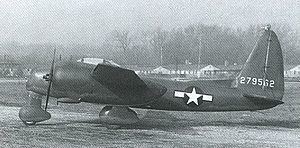First flight 1943 | ||
 | ||
The Fleetwings BQ-2 was an early expendable unmanned aerial vehicle — referred to at the time as an "assault drone" — developed by Fleetwings during the Second World War for use by the United States Army Air Forces. Only a single example of the type was built; the aircraft was deemed too expensive for service and was cancelled after a brief flight testing career.
Contents
Development
Development of the BQ-2 began on July 10, 1942, under a program for the development of "aerial torpedoes" - unmanned flying bombs - that had been instigated in March of that year. Fleetwings was contracted to build a single XBQ-2 assault drone, powered by two Lycoming XO-435 opposed piston engines, and fitted with a fixed landing gear in tricycle configuration; the landing gear was jettisonable for better aerodynamics.
The BQ-2 was optionally piloted; a single-seat cockpit was installed for ferry and training flights; a fairing would replace the cockpit canopy on operational missions. The BQ-2 was intended to carry a 2,000 pounds (910 kg) warhead over a range of 1,717 miles (2,763 km) at 225 miles per hour (362 km/h); the aircraft would be destroyed in the act of striking the target. A single BQ-1 was to be constructed as well under the same contract.
Flight testing
The XO-435 engines were dropped from the design of the XBQ-2 before completion, being replaced by two Lycoming R-680 radial engines, with the aircraft being redesignated XBQ-2A.
Following trials of the television-based command guidance system using a PQ-12 target drone, the XBQ-2A flew in mid 1943; following flight trials, the design was determined to be too expensive for operational use, and the program was cancelled in December of that year.
Specifications (XBQ-2A)
Data from
General characteristics
PerformanceArmament
